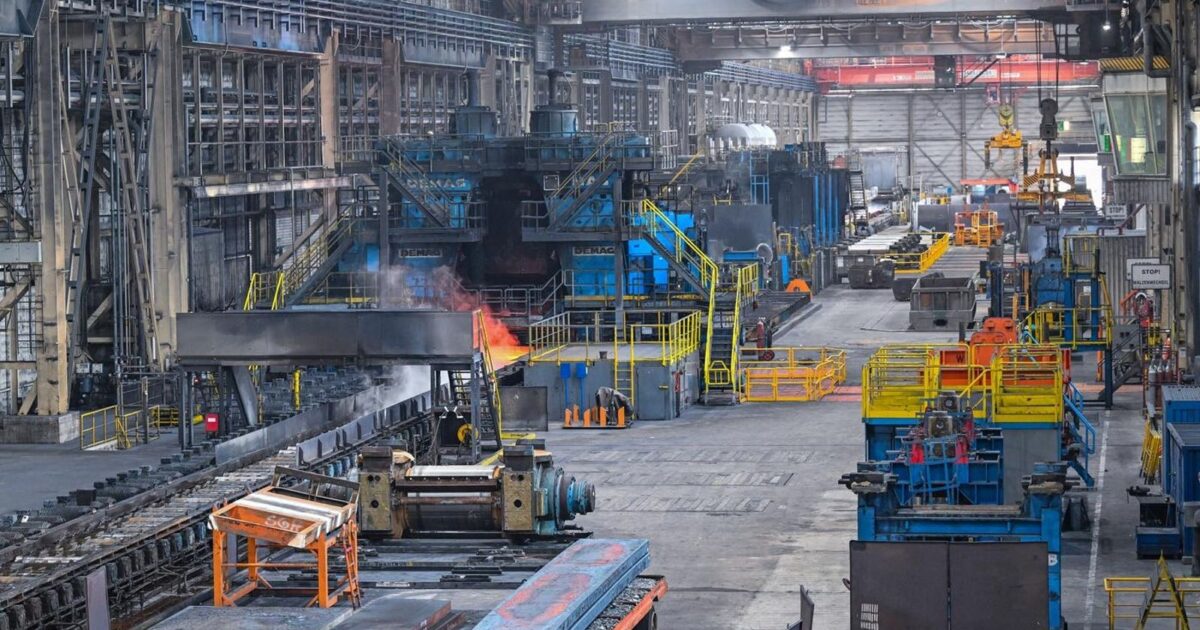Can AI Catalyze Global Progress?

30 May 2024, Brandenburg, Eisenhüttenstadt: The hot rolling mill of ArcelorMittal Eisenhüttenstadt GmbH. Photo: Patrick Pleul/dpa (Photo by Patrick Pleul/picture alliance via Getty Images)
dpa/picture alliance via Getty Images
According to the Intergovernmental Panel on Climate Change (IPCC), limiting global warming to below 1.5°C will require global greenhouse gas (GHG) emissions to fall by 43% by 2030 and 60% by 2035. Renewable energy and grid electrification serve as pathways for decarbonising the transportation and building sectors, among others, enabling these sectors to meet their climate targets over the coming decades. However, decarbonising hard-to-abate industrial subsectors, which include steel, cement, chemicals, aluminium and other energy-intensive basic materials used in construction and manufacturing, remains technically and economically challenging. Together, these industries accounted for approximately 40% of global energy consumption and over 30% of global GHG emissions in 2024 (Figure 1). While recent years have seen progress, with the intensity of industrial emissions decreasing by 4.1% between 2019 and 2023, the pace of decarbonisation remains insufficient to meet global net-zero ambitions.
Figure 1: Global Industrial GHG emissions (Scope 1 and 2) by Sub-Sector
Global GHG emissions (Scope 1 and 2) by Industrial Sub-Sector
World Economic Forum, 2024
New research from the World Economic Forum Net-Zero Industry Tracker estimates that the use of generative AI can improve capital efficiency by 5–7% and could save sectoral net-zero capital needs by US$1.5–2 trillion. These figures assume widespread adoption. Beyond capital savings, AI provides tools for reducing GHG emissions through optimised asset management, accelerated R&D, and improved transparency via product-level carbon reporting. However, the continuous operation of industrial AI systems will, itself, increase electricity demands, especially from data centres. This could nearly double the latter’s share of global electricity consumption from 1.5% in 2024 to 3% by 2030. Such growth raises critical questions about competition for limited low-carbon energy resources and AI’s net-emissions impact. Can artificial intelligence become a catalyst for industrial decarbonisation, or will its energy demands undermine climate progress? Answering that question begins with examining proven, real-world AI deployments that are already cutting industrial GHG emissions. It also requires confirming that the underlying computing infrastructure runs on low-carbon power and designing coordinated strategies to scale such AI-enabled decarbonisation solutions across heavy industry.
Emerging Industrial Use-Cases Demonstrate AI’s Potential To Reduce GHGs
Industrial subsectors account for a significant share of global GHG emissions. Cement production alone generates about 8% of global CO₂ because emissions arise both from the fuel burned in kilns and from the calcination of limestone into clinker. Iron and steelmaking add almost another 9%, as converting iron ore to liquid metal typically relies on coke-fired blast furnaces operating above 1,500 °C. Industrial heat, which is needed to run kilns, reactors, and boilers, represents roughly three-quarters of energy use in U.S. manufacturing and remains overwhelmingly fossil-fuelled. These energy-intensive subsectors help explain why, even after a 4.1% decline in emissions intensity between 2019 and 2023, global industry is still lagging behind net-zero targets.
AI offers ways of reducing emissions. For instance, advanced control systems can monitor process parameters such as flame shape, temperature distribution, fuel feed rates, and oxygen levels across the cement, chemical, and metal industries. According to Imubit, as fuel characteristics shift (for example, from high-calorific refuse-derived fuel (RDF) to moist biomass), the AI can adjust combustion settings in real time to maintain optimal conditions. AI can also fine-tune variables such as primary and secondary airflows, burner angles, and fuel injection rates faster and more precisely than human operators. This eliminates the need to run kilns hot as a safety margin, thereby improving energy efficiency by 5–10% and boosting downstream productivity by 3–8%. Consequently, clinker quality can be stabilised to allow operators to substitute more of the carbon‑intensive clinker with supplementary cementitious materials, such as slag or fly ash, without compromising strength. This can lower fuel use and CO₂ emissions, resulting in more durable concrete.
In steel, machine‑learning models are being deployed from the furnace floor to product development. ArcelorMittal used a bio‑inspired optimisation algorithm on a hot‑dip galvanising line and saved about US$1 million a year in energy and throughput costs. Its predictive maintenance platform, piloted in Canada and France, monitors hydraulic motors and other equipment, forecasting failures with near‑perfect accuracy and eliminating unplanned shutdowns. Such systems allow furnaces to operate closer to their optimal temperatures, cut waste, and extend asset life, thereby creating opportunities for emissions savings (assuming production levels remain constant). While AI-driven efficiency improvements can deliver valuable, near-term emissions cuts, they remain incremental next to the 70–90% reductions that breakthrough options—such as hydrogen-based steelmaking or carbon capture systems—could eventually achieve, albeit over deployment horizons of decades. Scaling such gains across global industrial operations will thus require coordinated infrastructure and policy support that work alongside breakthrough technologies.
Clean Power And Computing Are Needed To Complement AI’s Growing Use
Although existing AI-use cases foster a positive outlook, critics have pointed out that using AI and large language models (LLMs) could shift emissions from factories to servers. Indeed, the servers powering AI applications consumed roughly 1.5% of global electricity in 2024, and rising demand could double over the next decade as generative models proliferate. However, even a doubling would pale in comparison to current industrial energy consumption. Thermal processes alone account for 74% of U.S. manufacturing energy use—roughly 8,000 TWh annually—as opposed to data centres’ projected 1,000 TWh by 2030 (Figure 2).
Figure 2: Data Centre Electricity Demand, Historical and Projected Until 2035
Data Centre Electricity Demand, Historical and Projected Until 2035
International Energy Agency, 2025
To address AI’s growing energy footprint, the priority should be to build computing infrastructure powered by renewable or zero‑carbon resources. The Nordic countries exemplify this approach: Norway and Iceland already generate virtually all of their grid electricity from renewables, while Sweden, Denmark and Finland have among the highest renewable shares in Europe. Abundant hydropower, wind and geothermal resources allow many Nordic data centres to operate with negligible emissions. Finland and Sweden have attracted major hyperscale facilities that run on green energy and feed waste heat to district‑heating networks. Similarly, Iceland’s cool climate and abundant geothermal power provide an ideal environment for energy‑intensive computing. Coal-heavy economies face a more challenging transition, but the trend is shifting: renewables now account for roughly 35% of China’s electricity and 56% of its total installed capacity, and new national rules require that newly-built data-centre hubs source at least 80% of their power from renewables. India has crossed 200 GW of renewables—about 46% of installed capacity—and is targeting 500 GW of non-fossil capacity by 2030, backed by transmission-fee waivers and green-hydrogen incentives. Coordinated AI deployment on these expanding clean grids could help both countries decouple industrial growth from coal-fired power.
AI hardware itself is also becoming more efficient. Improvements in AI chip architectures, such as specific NVIDIA data processing units, have demonstrated up to 30% efficiency gains in select applications. These gains complement AI’s direct role in accelerating decarbonisation through emerging “cleanAI” applications, which pair AI with clean‑energy technologies to accelerate the clean economy transition. For example, startups like Mitra Chem use machine-learning-driven lab automation to simulate, synthesise, and test thousands of battery-cathode formulations each month, with a particular focus on iron-based chemistries (e.g., LFP/LMFP) that avoid the nickel- and cobalt-intensive materials dominating today’s EV batteries. Similarly, Emmi AI and PhysicsX optimise industrial processes through generative models for mechanical and chemical simulations, enabling engineers to design components and optimise chemical reactions in silico rather than through energy‑intensive trial and error.
Although overall server efficiency improvements vary significantly across hardware configurations, these developments demonstrate that AI’s energy challenge can become a climate opportunity. With clean computing infrastructure and cleanAI applications, the technology that currently threatens to shift emissions from factories to servers can instead accelerate the decarbonisation of both digital and physical systems. The key is ensuring AI’s projected growth occurs on grids powered by the same renewable energy that heavy industry increasingly needs. When clean electricity is abundant and cheap, AI scaling supports rather than competes with industrial decarbonisation efforts.
CleanAI Clusters Can Scale Industrial Decarbonisation
According to the OECD, industrial sectors such as chemicals, textiles, metal products, and construction exhibit low AI intensity, as widespread AI adoption in heavy industry faces significant obstacles: High upfront costs, legacy infrastructure, and data fragmentation create implementation challenges. Chemicals, metals, and cement, in particular, tend to lag because they still rely on analogue control systems and manual optimisation (Figure 3). Underinvestment leaves enormous efficiency gains unrealised, which is why public‑sector incentives and private capital will be necessary for developing and scaling AI solutions. But, importantly, AI should be viewed as an enabler of industrial transformation rather than a silver bullet, in working alongside breakthrough technologies like clean hydrogen and carbon capture to achieve net-zero targets.
Figure 3: Sectoral taxonomy of AI intensity by indicator
Sectoral taxonomy of AI intensity by indicator
OECD, 2025
A practical way to cultivate these synergies is to develop cleanAI clusters that concentrate industrial facilities, AI companies, clean-energy infrastructure and research institutions in the same region. Unlike today’s geographically dispersed initiatives, such as Europe’s hydrogen-focused Heavenn Valley or the continent-wide network of AI clusters, these hubs would deliberately co-locate steel mills, cement plants and chemical sites with AI firms and renewable-power assets. Such proximity enables shared clean-electricity infrastructure, joint R&D on industrial-AI applications and coordinated workforce training. With the window for industrial decarbonisation closing, AI itself is a powerful near-term tool while breakthrough technologies mature. Industry, start-ups, researchers and policymakers should therefore pursue coordinated strategies to deploy it across the industrial sector.

